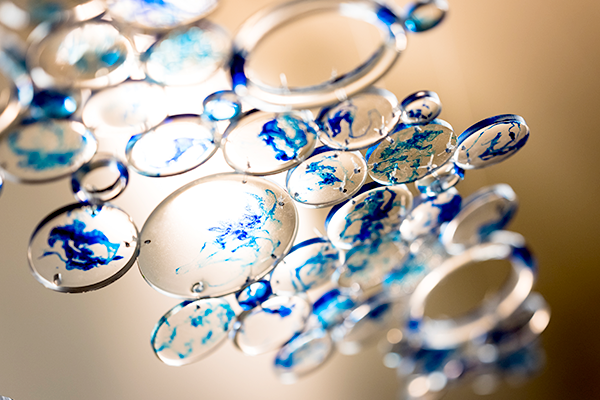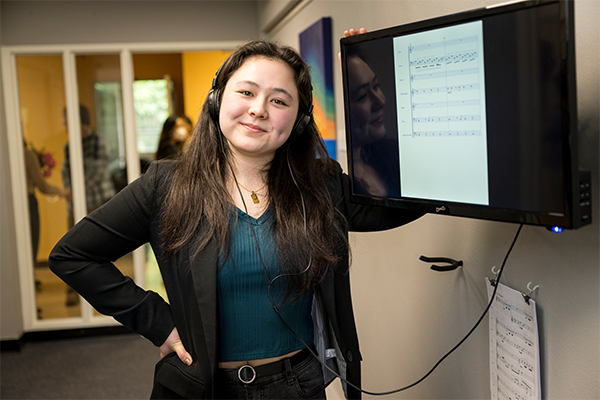New initiative makes space for students to communicate research creatively
It’s one thing to read the latest research papers about how noise pollution affects the ability of birds to communicate in urban cityscapes.
It’s quite another to listen to the trill of birdsong layered atop car horns and the dull roar of traffic, and to perceive at a fundamental level how the different sounds must compete to be heard.
The reimagining of scientific data via the arts is at the heart of Oregon State University’s Art-Sci Initiative and its new interdisciplinary fellowship program, which began last school year with 11 undergraduate and graduate fellows. The program gives students space to express the full breadth of their academic interests while creating new models for interpreting the most pressing problems in the world today.

“Science is inaccessible to a lot of people, the way it’s presented,” said Jerri Bartholomew, a microbiology professor and one of the founding members of the Art-Sci Initiative. “What we’re hoping is that by training some of these students who are already in sciences to tune their artistic approach, they can communicate more effectively and start to ask different kinds of questions in their research.”
Liana Kruger-Moore is one of those students. She graduated in June with her bachelor’s in animal science and a minor in musical performance. The daughter of two professional classical musicians, she always dreamed of becoming a zoo veterinarian but could never give up her love of music.
“That was a part of me as much as wanting to do the sciences,” said Kruger-Moore, who plays flute and violin and is going to veterinary college in the fall. “But in college, I realized the university is not necessarily built for people to focus on more than one area.”
As a senior, she learned she could receive a $1,000 stipend to create an artistic piece based on a research topic of her choice through the Art-Sci Initiative pilot fellowship. She made recordings in Portland and in a residency at OSU’s Cabin at Shotpouch Creek, layering them into an original musical composition that explores the differences in soundscapes in rural and urban areas with a focus on birds, combining her passions for music and animals.
Especially in urban areas, noise pollution harms birds’ ability to communicate, whether they’re competing with the low-frequency hum of traffic or suffering damage to their ear follicles caused by loud construction. It leads to chronic health problems and drowns out mating and warning calls.
“I wanted to use music to make it more accessible to the average person, to make it really obvious how different it sounds to be in nature versus how it sounds to be in an urban environment,” Kruger-Moore said. “So you feel more immersed, as if you were a bird in these environments, and you can experience which sounds are louder, which are softer; which sounds you can hear and which you can’t hear because they’re being drowned out.”

Kruger-Moore wanted to help humans hear like birds. Doctoral student Aliya Jamil wanted to make the invisible visible.
Jamil is studying biophysical interactions in the College of Earth, Ocean, and Atmospheric Sciences. Her project was a resin-based sculpture exploring different spatial scales of the marine ecosystem and how climate change is affecting the tiny phytoplankton at the base of the food web.
Phytoplankton are a critical part of removing carbon from the atmosphere, but they’re so small that it’s hard to get people to understand their importance, Jamil said.
“The creative process in art, I’m finding to be really similar to the scientific process and how I approach my research,” she said. “I think it allows us to play with ideas we otherwise wouldn’t, and maybe it’ll help you reframe how you think about some process or pattern you’re seeing in your data.”
Students in the fellowship team up with faculty mentors from both the humanities and science fields, meeting at least once a month throughout the year. Jamil’s science mentor, microbiology post-doctoral scholar James Fox, said one of the reasons he joined Art-Sci was his frustration with the way academic research tends to stay confined to academia.
“There are many people who try and bridge that divide of public opinion and policy and scientific research, but I feel like as a body of researchers, we’re constantly churning out more and more information that never gets through to the public,” Fox said. “I’m interested from an outreach perspective;
"I want to understand how to communicate important research and make it more relatable.”
When the founding Art-Sci Initiative team proposed creating a fellowship in 2022, they quickly received support from around the university as well as from a private donor, said Carly Lettero, the new associate director of art, science, humanities and technology integration in the Patricia Valian Reser Center for the Creative Arts (PRAx).
And after the success of the pilot year, 10 of OSU’s 11 colleges have signed on to provide financial and programming support going forward.
“It’s the only thing I’ve ever done where everyone we asked said yes,” Lettero said. “It really felt like so many people have been building the art-sci momentum over the years, and now we’re entering a new phase. With the opening of PRAx, it’s like the stars aligned for this fellowship to get a lot more support.”
Collaboration between the arts and sciences is central to the mission of PRAx, which will provide a home for the initiative along with several other “orphan” transdisciplinary programs from across the university, said Peter Betjemann, the Patricia Valian Reser Director of Arts and Education.
The program has expanded this year from 11 to 24 fellows, adding tracks for Film-Science, Engineering-Art and Humanities-Science, and will also hold monthly public Art-Sci events. (Look for upcoming events at artsci.oregonstate.edu.)
“Everybody’s learning together,” Lettero said. “What’s really exciting about this kind of work is that it brings together multiple ways of looking at an issue; multiple ways of asking new questions about it. Which ultimately leads to new thinking and new ways of being in the world, which is really what we need right now.”
Scan this code with your smart phone’s camera to listen to Liana Kruger-Moore’s bird song composition, “Frequencies.”
**SITE NOT FOUND: bit.ly_OSUfrequencies.jpg

